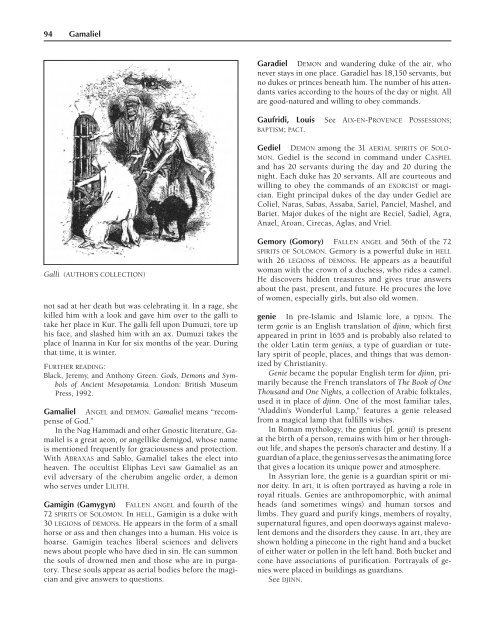The Encyclopedia Of Demons And Demonology
The Encyclopedia Of Demons And Demonology
The Encyclopedia Of Demons And Demonology
Create successful ePaper yourself
Turn your PDF publications into a flip-book with our unique Google optimized e-Paper software.
94 Gamaliel<br />
Garadiel DEMON and wandering duke of the air, who<br />
never stays in one place. Garadiel has 18,150 servants, but<br />
no dukes or princes beneath him. <strong>The</strong> number of his attendants<br />
varies according to the hours of the day or night. All<br />
are good-natured and willing to obey commands.<br />
Gaufridi, Louis<br />
BAPTISM; PACT.<br />
See AIX-EN-PROVENCE POSSESSIONS;<br />
Gediel DEMON among the 31 AERIAL SPIRITS OF SOLO-<br />
MON. Gediel is the second in command under CASPIEL<br />
and has 20 servants during the day and 20 during the<br />
night. Each duke has 20 servants. All are courteous and<br />
willing to obey the commands of an EXORCIST or magician.<br />
Eight principal dukes of the day under Gediel are<br />
Coliel, Naras, Sabas, Assaba, Sariel, Panciel, Mashel, and<br />
Bariet. Major dukes of the night are Reciel, Sadiel, Agra,<br />
Anael, Aroan, Cirecas, Aglas, and Vriel.<br />
Galli (AUTHOR’S COLLECTION)<br />
not sad at her death but was celebrating it. In a rage, she<br />
killed him with a look and gave him over to the galli to<br />
take her place in Kur. <strong>The</strong> galli fell upon Dumuzi, tore up<br />
his face, and slashed him with an ax. Dumuzi takes the<br />
place of Inanna in Kur for six months of the year. During<br />
that time, it is winter.<br />
FURTHER READING:<br />
Black, Jeremy, and Anthony Green. Gods, <strong>Demons</strong> and Symbols<br />
of Ancient Mesopotamia. London: British Museum<br />
Press, 1992.<br />
Gamaliel ANGEL and DEMON. Gamaliel means “recompense<br />
of God.”<br />
In the Nag Hammadi and other Gnostic literature, Gamaliel<br />
is a great aeon, or angellike demigod, whose name<br />
is mentioned frequently for graciousness and protection.<br />
With ABRAXAS and Sablo, Gamaliel takes the elect into<br />
heaven. <strong>The</strong> occultist Eliphas Levi saw Gamaliel as an<br />
evil adversary of the cherubim angelic order, a demon<br />
who serves under LILITH.<br />
Gamigin (Gamygyn) FALLEN ANGEL and fourth of the<br />
72 SPIRITS OF SOLOMON. In HELL, Gamigin is a duke with<br />
30 LEGIONs of DEMONs. He appears in the form of a small<br />
horse or ass and then changes into a human. His voice is<br />
hoarse. Gamigin teaches liberal sciences and delivers<br />
news about people who have died in sin. He can summon<br />
the souls of drowned men and those who are in purgatory.<br />
<strong>The</strong>se souls appear as aerial bodies before the magician<br />
and give answers to questions.<br />
Gemory (Gomory) FALLEN ANGEL and 56th of the 72<br />
SPIRITS OF SOLOMON. Gemory is a powerful duke in HELL<br />
with 26 LEGIONs of DEMONs. He appears as a beautiful<br />
woman with the crown of a duchess, who rides a camel.<br />
He discovers hidden treasures and gives true answers<br />
about the past, present, and future. He procures the love<br />
of women, especially girls, but also old women.<br />
genie In pre-Islamic and Islamic lore, a DJINN. <strong>The</strong><br />
term genie is an English translation of djinn, which first<br />
appeared in print in 1655 and is probably also related to<br />
the older Latin term genius, a type of guardian or tutelary<br />
spirit of people, places, and things that was demonized<br />
by Christianity.<br />
Genie became the popular English term for djinn, primarily<br />
because the French translators of <strong>The</strong> Book of One<br />
Thousand and One Nights, a collection of Arabic folktales,<br />
used it in place of djinn. One of the most familiar tales,<br />
“Aladdin’s Wonderful Lamp,” features a genie released<br />
from a magical lamp that fulfills wishes.<br />
In Roman mythology, the genius (pl. genii) is present<br />
at the birth of a person, remains with him or her throughout<br />
life, and shapes the person’s character and destiny. If a<br />
guardian of a place, the genius serves as the animating force<br />
that gives a location its unique power and atmosphere.<br />
In Assyrian lore, the genie is a guardian spirit or minor<br />
deity. In art, it is often portrayed as having a role in<br />
royal rituals. Genies are anthropomorphic, with animal<br />
heads (and sometimes wings) and human torsos and<br />
limbs. <strong>The</strong>y guard and purify kings, members of royalty,<br />
supernatural figures, and open doorways against malevolent<br />
demons and the disorders they cause. In art, they are<br />
shown holding a pinecone in the right hand and a bucket<br />
of either water or pollen in the left hand. Both bucket and<br />
cone have associations of purification. Portrayals of genies<br />
were placed in buildings as guardians.<br />
See DJINN.












